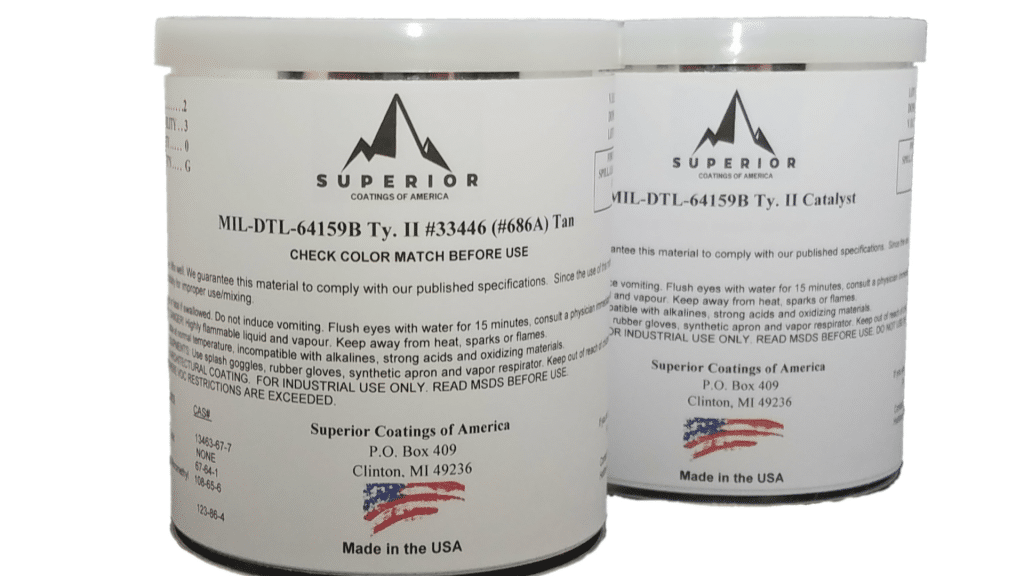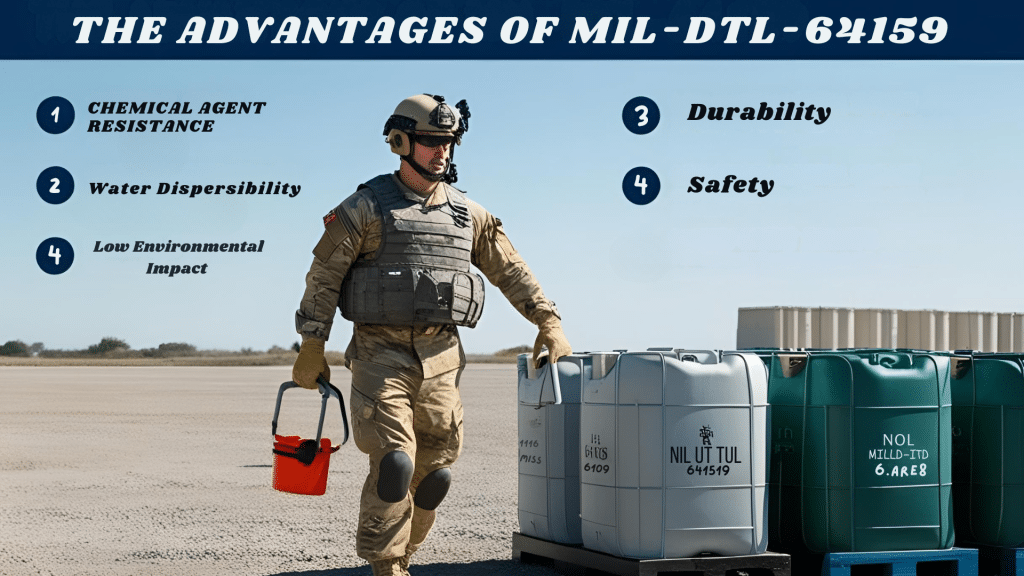Military equipment needs special protection in the field. Many coatings fail to provide the right mix of durability and safety under extreme conditions.
MIL-DTL-64159 addresses this issue by providing a layer that resists chemical attacks while remaining safe for both users and the environment.
This water-based polyurethane creates a tough shield that protects valuable equipment from threats both natural and human-made. This guide provides an overview of everything you need to know about MIL-DTL-64159 coatings.
You’ll learn about the three main types available, their key benefits, including chemical resistance and durability, and practical application methods.
We’ll also cover mixing ratios, curing processes, and why Type II has become the standard for military applications.
By the end, you’ll understand why these coatings are crucial for military operations worldwide.
What Is MIL-DTL-64159?
MIL-DTL-64159 refers to a key military standard for protective coatings. The full title is “Coating, Water Dispersible Aliphatic Polyurethane, Chemical Agent Resistant (CARC).” This specification sets the rules for paints used on military vehicles and equipment.
The primary purpose of this coating is to protect soldiers. It creates a tough outer layer that resists harmful chemicals that might be used in warfare. The coating adheres well to metal and forms a durable barrier that withstands years of harsh conditions.
These coatings are used on many types of military assets. You’ll find them on ground vehicles, such as trucks and tanks. They’re also applied to aviation equipment and various support tools used in the field. The coating is effective on multiple metal surfaces, including steel and aluminum.
The Three Types of MIL-DTL-64159 Coatings and Their Applications

MIL-DTL-64159 coatings are available in three primary types, each with distinct uses and characteristics. These types differ based on their flattening agents, which affect the appearance of the paint when dry.
Type I uses silica-based flattening agents. These provide the coating with a flat, non-glossy finish that helps conceal military assets. The matte surface reduces light reflection, making vehicles and equipment less visible to enemies.
Type II contains polymeric flattening agents instead of silica. This type has become the most common choice for general painting needs. Type II coatings provide superior weather resistance and last longer in harsh outdoor environments.
Type III consists of self-contained portable kits with Type II coatings. These kits are designed for quick field touch-ups in the event of damage. They enable soldiers to address coating issues promptly without requiring full painting equipment.
Most military units now use Type II for their standard painting work. This preference comes from the better overall performance and ease of use that Type II offers compared to the other options.
The Advantages of MIL-DTL-64159: Features That Set It Apart
MIL-DTL-64159 offers a range of advanced features, including chemical resistance, durability, and environmental safety, making it the go-to standard for military camouflage coatings. In this section, we examine the key advantages that distinguish this specification from others.

1. Chemical Agent Resistance
The most important quality of MIL-DTL-64159 is its ability to resist chemical weapons. This coating creates a strong barrier that blocks harmful agents from reaching the surface beneath. Military personnel can quickly clean these chemicals off, keeping themselves safe in hazardous situations.
2. Water Dispersibility
These coatings mix with water instead of harsh solvents. This makes them easier to apply in various settings. Cleanup requires only water, not special chemicals. Teams can work more efficiently with less specialized equipment.
3. Low Environmental Impact
MIL-DTL-64159 coatings are more environmentally friendly for our planet. They don’t contain the most harmful air pollutants that damage the ozone layer. The maximum VOC content remains below 220 g/L, meeting strict air quality regulations. This protects both users and the environment during the application.
4. Durability
These coatings withstand rough conditions. They resist:
- Scratches and wear from daily use
- Harsh weather, including rain, sun, and extreme temperatures
- Rust and corrosion that normally damage metal surfaces
5. Safety
Modern MIL-DTL-64159 formulas don’t contain lead or chromates. This makes them safer for the people applying them and anyone who comes in contact with the coated equipment. The absence of these toxic materials creates a healthier workplace without sacrificing performance.
Military Standard Color Options and FED-STD-595 Color Number
| Color Name | FED-STD-595 Color Number |
|---|---|
| Tan | 686A (33446) |
| Aircraft Green | 34031 |
| Black | 37030 |
| Brown | 383 30051 |
Application and Usage of Mil-DTL-64159
- Recommended substrates: MIL-DTL-64159 is most effective on steel, aluminum, galvanized metals, and similar metal surfaces.
- Application methods: Users can apply the coating by brushing, rolling, or spraying it onto prepared surfaces.
- Mixing ratio: Always mix at a ratio of 2 parts Component A to 1 part Component B by volume for proper curing.
- Thinning: If the coating is too thick, thin it with deionized or distilled water to achieve the desired consistency.
- Curing: The coating cures naturally through air drying or through forced drying with heat when time is limited.
Conclusion
MIL-DTL-64159 coatings play a vital role in military operations. They provide more than just color—they offer protection that can save lives and equipment in dangerous situations.
The three types of coatings—silica-based Type I, polymeric Type II, and portable Type III kits—give military teams options for different needs. Type II has proven most useful for general applications due to its balance of protection and longevity.
The benefits of these coatings extend beyond chemical resistance. Their water-based formula makes them easier to use and more environmentally friendly. The durability protects equipment from daily wear, harsh weather, and corrosion.
When applying these coatings, following the correct mixing ratio and application methods ensures the best results. The 2:1 ratio of Components A and B creates the strongest finish.
What questions do you have about these important protective coatings?
Frequently Asked Questions
How Long Does Mil-DTL-64159 Coating Last Before Needing Reapplication?
Under normal use conditions, the coating typically lasts 5-7 years before touch-ups become necessary.
Can Mil-DTL-64159 Be Applied Over Existing Paint Systems?
Yes, but the old surface must be cleaned, sanded, and primed properly for good adhesion.
What Temperature Range Can Mil-DTL-64159 Coatings Withstand Once Cured?
These coatings perform well from -40°F to +180°F without losing their protective qualities.
Is Special Training Required to Apply Mil-DTL-64159 Coatings?
Basic painting skills are sufficient, but users should consult technical data sheets for optimal results.


